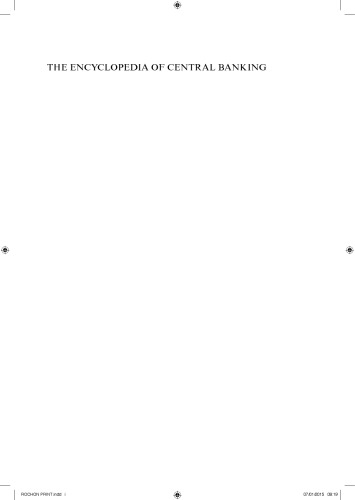Product desciption
The Encyclopedia Of Central Banking Cased Louisphilippe Rochon And Sergio Rossi by Louis-philippe Rochon And Sergio Rossi 9781782547433, 1782547436 instant download after payment.
Central banking (that is, the variety of policy targets, strategies, and instruments used by
monetary authorities all around the world) has become an important topic of discussion
in many circles beyond the economics profession, most notably at the political level and
in society at large. Owing to the global financial crisis induced by the demise of Lehman
Brothers on 15 September 2008, all major central banks in the world have been led to
intervene in order to avert the collapse of the global economy, mainly as a result of the
meltdown of their “globalized” financial systems. Since then, monetary policy has been
in the foreground (to try) to address a number of issues raised by such a systemic crisis
at a global level. Both supporters of and opponents to monetary- policy interventions are
being forced to learn, from empirical evidence more than from conventional economic
wisdom, that several firmly held beliefs in monetary macroeconomics are essentially
wrong or flawed. This is so much so that even the nature of money itself is fundamentally
different from its simplistic understanding – within the central banks’ community as well
as beyond it (see McLeay et al., 2014).
As a matter of fact, the global financial crisis has forced many, particularly within the
mainstream of the profession, to rethink afresh how central banks operate and also the
nature of money and banking. Indeed, the established view about money’s exogeneity –
epitomized by Friedman’s (1969, pp. 4–5) conception of “helicopter money” – as well
as the causal link between bank deposits and bank loans, have been proven wrong by
an increasing volume of empirical evidence across the global economy. To be truthful,
several heterodox economists have been pointing out (since the 1980s, if not earlier) that
in our economic systems money is an endogenous magnitude, whose issuance depends on
banks’ credit lines independently of any pre- existent deposits with them. In this regard,
central banks are settlement institutions on the interbank market, where they set the socalled
policy rate(s) of interest in order to hit their monetary- policy goals eventually. That
being the case, then any central- bank intervention that does not consider this empirical
evidence can only by chance (rather than by design) affect the relevant economic
system as intended by policy makers and the scientific community inspiring them. For
instance, so- called “quantitative easing” programmes put into practice on both sides of
the Atlantic cannot be successful, as they are inspired by the erroneous belief that money
is exogenous and the central bank can induce banks to provide more credit lines to both
households and non- financial firms just by increasing the volume of banks’ “liquidity”
in the central bank vaults.
This Encyclopedia aims at providing a critical understanding of central banking, based
on a plural perspective on several issues at both theoretical and policy- oriented levels. It
intends to explain the complexity of monetary- policy interventions, their conceptual as
well as institutional frameworks, and their own limits and drawbacks. It is informative,
as it provides the reader with the body of knowledge that is necessary to understand the
background of central banks’ decisions in the aftermath of the global financial crisis. It
is stimulating, because it offers different and at times controversial explanations of the
same subject matter, illuminating it also from a historical point of view. The history ofmonetary thinking, indeed, is seminal for understanding both current monetary thought
and contemporary monetary- policy decisions – both when they are right and when they
are wrong, to paraphrase Keynes’s (1936, p. 383) argument with respect to economists’
ideas.
The more than 150 contributors to this collective effort have been confronted with the
challenge of writing nearly 250 entries in a clear and comprehensive way, considering
the space constraint imposed by such a voluminous, but synthetic work. They are all
warmly thanked for having accepted this challenge, whose outcomes should contribute to
a much better, and sound, understanding of an essential item (money) and an important
institution (the central bank) for the “common good”. The editors of this volume wish
also to thank the publishers, whose professional involvement made it possible for this
Encyclopedia to see the light in a timely manner for central banking with regard to the still
open issues raised by the global financial crisis as well as by its dramatic and still largely
unsettled consequences for a variety of stakeholders across the world.
Louis- Philippe Rochon, Laurentian University, Canada
Sergio Rossi, University of Fribourg, Switzerland
References
Friedman, M. (1969), The Optimum Quantity of Money and Other Essays, Chicago: Aldine.
Keynes, J.M. (1936), The General Theory of Employment, Interest and Money, London: Macmillan.
McLeay, M., A. Radia and R. Thomas (2014), “Money creation in the modern economy”, Bank of England
Quarterly Bulletin, 54 (1), pp. 14–27.


